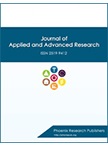Comparative study of antimicrobial efficiency of biosurfactant producing Pseudomonas spp. from different soil samples
DOI:
https://doi.org/10.21839/jaar.2020.v5.318Keywords:
Biosurfactant, contaminated soil sample, Pseudomonas spp., antimicrobial activity.Abstract
Amphiphilic biosurfactants are surface-active biological molecules secreted by hydrocarbanoclastic microorganisms. Biosurfactants are eco-friendly, less toxic, biodegradable, and low-cost material, so it has more advantages over chemical surfactants. In this research, Pseudomonas spp., biosurfactant producing microorganisms isolated from different sources of soil samples. IS1, IS2, IS3, IS4 isolates obtained from Garden soil sample; Metal contaminated soil sample; Petroleum contaminated soil sample; Oil contaminated soil sample; respectively. Each isolates identified as Pseudomonas spp. Furthermore, screened for biosurfactant producers. Each isolate showed positive results for the hemolysis test, drop collapse test, oil displacement test, and emulsification test. All isolate incubated in mineral salt medium for biosurfactant production. Biosurfactant extracted from IS1, IS2, IS3, IS4 showed 35%, 65%, 20%, 52% emulsification index respectively. Antimicrobial activity of extracted biosurfactants against pathogenic microorganisms checked by agar cup method. IS2 isolate shows the highest antimicrobial activity among all. All isolate showed a higher zone of inhibition against gram-positive microorganisms than gram-negative microbes. The purpose of this study involves the assessment of the antimicrobial activity of biosurfactant producers from the soil environment.





 .
.